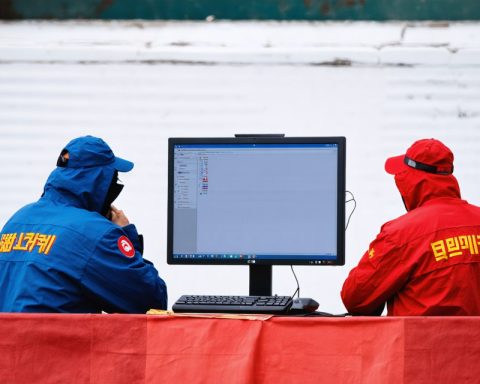- Grocery Outlet Holding’s stock plummeted by 23% over the last three months, raising concerns about its financial health.
- The company’s Return on Equity (ROE) is alarmingly low at 3.3%, significantly below the industry average of 14%.
- Net income has decreased by 2.1% over the past five years, while competitors enjoyed a 12% growth rate.
- The lack of dividend distribution suggests a focus on reinvestment despite sluggish growth and potential internal challenges.
- Analyst predictions show optimism for future earnings growth, although caution is warranted given past performance.
- Investors must carefully assess whether current valuations reflect future opportunities or potential pitfalls.
A noticeable chill has swept over Grocery Outlet Holding’s stock performance, with a staggering 23% dip over just three months leaving investors pondering the underlying reasons. The financial whispers suggest deeper concerns, primarily spotlighting the company’s alarmingly low Return on Equity (ROE). For those less versed in corporate finance, ROE is a critical measure of how effectively a company uses its shareholders’ capital to generate profits, akin to evaluating the productivity of a cherished homekeeper’s use of your grandmother’s recipe.
Grocery Outlet Holding’s ROE currently languishes at a mere 3.3%, a stark contrast to the sturdy 14% ROE benchmark seen across its industry peers. Imagine the industry as a bustling local market, where neighboring stalls are replete with eager customers and the smell of profit wafts through the air, while Grocery Outlet’s underground, beleaguered corner remains enveloped in the shadow of unrealized potential.
A decline of 2.1% in net income over half a decade paints a picture of a company trudging a muddy path, while competitors sprint ahead with a brisk 12% earnings growth rate during the same period. It’s like watching a determined turtle trying to catch up to a sprinting hare—inevitably fascinating, yet ultimately frustrating for passive onlookers.
Compounding this, Grocery Outlet has chosen not to distribute dividends, signaling a desire to reinvest profits into the business. Yet, one is left wondering—why does the company retain its earnings if the seeds of growth struggle to sprout? Perhaps external pressures such as fierce market competition, or internal inefficiencies yet undisclosed, loom larger than anticipated.
Despite the current bleakness, a glimmer of optimism flickers in analyst predictions projecting future earnings growth. While the past five years evoke the specter of missed opportunities, the road ahead seems potentially brighter—though marked with cautionary tales of the past.
For investors, this scenario demands a discerning eye. Is the stock’s current valuation reflective of future prosperity, or does it mask deeper pitfalls to come? Navigating this financial terrain necessitates more than just hope; it requires a keen understanding of market dynamics and a constant ear to the ground for those faint whispers of change.
This unfolding narrative of Grocery Outlet Holding serves as a firm reminder: in the market, as in life, what lies beneath the surface often dictates the depths into which we are allowed to delve.
Why Grocery Outlet Holding’s Stock is Facing Turbulence: An In-Depth Analysis
Introduction
Grocery Outlet Holding’s recent stock decline of 23% in just three months has raised concerns among investors. The company attributes its troubling financial performance mainly to its low Return on Equity (ROE), which stands at a mere 3.3%, significantly lagging behind the industry average of 14%. This article will delve deeper into the potential causes, controversies, and future predictions for Grocery Outlet, aiming to answer pressing investor questions and provide actionable insights for navigating the company’s financial landscape.
Understanding ROE and Its Impact
What is ROE?
ROE measures how effectively a company is using its shareholders’ equity to generate profits. A higher ROE indicates more efficient management and higher profitability.
The Significance of Low ROE:
Grocery Outlet’s 3.3% ROE suggests inefficiencies in utilizing its assets to create value for shareholders. This is a red flag for investors because it implies the company is not maximizing its capital use, especially critical when compared to industry peers who achieve a 14% benchmark.
Key Factors Behind the Decline
1. Income and Earnings Trends:
– A 2.1% decline in net income over the past five years paints a worrying picture. This stagnation, juxtaposed with competitors’ 12% growth, suggests potential internal inefficiencies or strategic misalignments.
2. Dividend Policy:
– By not distributing dividends, Grocery Outlet aims to reinvest profits. However, without visible growth, investors may view this as a lack of immediate shareholder returns or confidence.
3. Market Competition and Internal Challenges:
– Increased market competition could be squeezing margins. Additionally, undisclosed internal inefficiencies may be affecting overall performance.
Future Prospects
Analyst Outlook:
Despite current challenges, some analysts predict future earnings growth for Grocery Outlet, indicating potential profitability improvements. However, caution is advised, impacted by past performance issues.
Practical Tips for Investors
1. Exercise Caution:
– Investors should stay informed on industry trends and Grocery Outlet’s quarterly earnings reports to assess any changes in ROE and growth strategies.
2. Diversification:
– Diversify your investment portfolio to mitigate risks associated with single-company stocks, particularly those with uncertain forecasts.
3. Monitor Competitor Performance:
– Keeping an eye on industry peers can help anticipate changes in market dynamics and potential opportunities that Grocery Outlet might capitalize on.
Industry Trends and Predictions
Supermarket and Grocery Industry Outlook:
According to MarketWatch and Statista, the retail grocery sector is expected to grow steadily, driven by consumer demand for convenience and healthier food options. Grocery Outlet might leverage these trends if it adapts its business models accordingly (Statista).
Conclusion
Grocery Outlet Holding is navigating a complex landscape of challenges, with its low ROE and recent financial performance raising legitimate investor concerns. However, understanding the implications of ROE, staying informed about industry trends, and employing prudent investment strategies can help mitigate risks and identify potential growth opportunities.
Actionable Steps for Investors:
– Continuously review industry reports and forecasts.
– Examine company press releases and earnings calls for updates on strategic direction.
– Engage with credible financial advisors before making investment decisions.
In the ever-changing grocery retail landscape, the key is staying informed and agile to capitalize on emerging opportunities.










